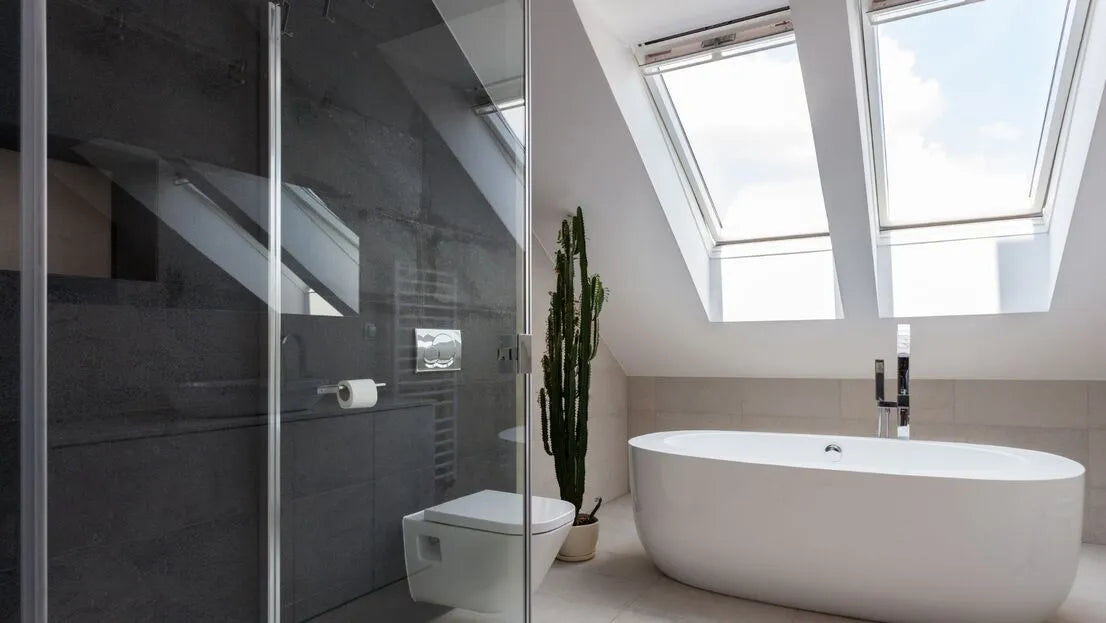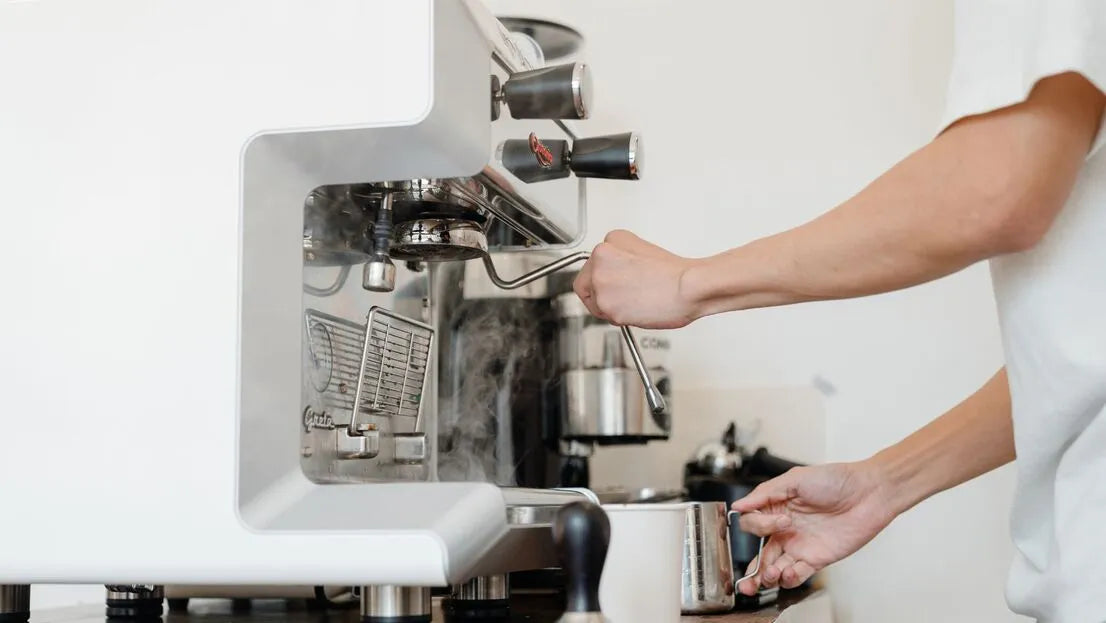Dusche entkalken

Bild: Kalkablagerungen ist ein häufiges Problem in Badezimmern
Das Thema Kalk ist besonders im Badezimmer präsent, denn wer kennt es nicht: Die unschönen weißen Flecken an den Wänden der Duschkabine, auf den Fließen und auf den Armaturen sorgen regelmäßig dafür, dass wir genervt im Badezimmer stehen, denn weiße Kalkflecken sehen nicht sehr ästhetisch aus. Spätestens, wenn der Duschkopf nicht mehr die volle Leistung bringt, ist es an der Zeit, die Dusche von Kalk zu befreien. In diesem Text erfahren Sie, wie Sie Ihre Dusche entkalken können, was Sie dabei beachten müssen und wie Sie Kalkablagerungen vorbeugen können.
Warum Sie Ihre Duschkabine entkalken sollten
Neben dem ästhetischen Aspekt darf der hygienische nicht aus den Augen gelassen werden: Ein verkalkter Duschkopf kann dafür sorgen, dass sich an den Kalkablagerungen Bakterien sammeln und bei jeder Duscheinheit mit aus dem Duschkopf gespült werden. Deshalb ist eine regelmäßige Reinigung der Duschkabine inklusive Duschkopf sehr zu empfehlen. In Regionen mit kalkhaltigem, besonders hartem Wasser bilden sich meist schneller Kalkablagerungen als in Regionen mit weichem Wasser. Es wird empfohlen, die Duschkabine inklusive der Armaturen mindestens ein Mal im Monat zu reinigen und zu entkalken. Je nachdem wie häufig geduscht wird und in welcher Region Sie leben, sollten Sie den Duschkopf alle drei bis vier Monate oder ein Mal im Jahr entkalken.
Duschkabine entkalken: so funktioniert's
Badreiniger sind die Mittel der Wahl, wenn es um die Bekämpfung von Kalkablagerungen in der Dusche geht. Die Anwendung ist ebenso einfach wie effektiv: Die betroffene Stelle einsprühen, das Mittel einwirken lassen und nach ein paar Minuten mit einem nassen Lappen die Kalkablagerungen abwischen. Um eine makellose Duschkabine zu erhalten, sollten Sie mit einem Mikrofasertuch die behandelte Stelle trocken polieren und Ihre Duschkabine erstrahlt in neuem Glanz.
Bei leichten Kalkverschmutzungen sprühen Sie den Badreiniger großflächig auf Ihre Duschglaswand, lassen diesen wieder ein paar Minuten lang einwirken und ziehen anschließend das Mittel mit einem Fensterputzer samt Kalkresten ab. Ihre Duscharmatur entkalken Sie ebenso effektiv mit einem Badreiniger. Achten Sie dabei darauf, dass Sie jede Stelle besonders sorgfältig behandeln und gehen Sie mit einem trockenen Tuch über die Armaturen. So gewinnt auch Ihre Duscharmatur ihren Glanz zurück.
Dusche entkalken mit Hausmitteln
Wer auf eine sparsamere und zugleich umweltfreundlichere Lösung zurückgreifen möchte, sollte zu Essig und Zitrone greifen. Für die Entkalkung Ihrer Duschglaswand eignet sich sowohl handelsüblicher Haushaltsessig als auch Essigessenz, Zitronensäure oder eine halbe Zitrone. Essigessenz und Zitronensäure sollten Sie mit klarem, kaltem Wasser im Verhältnis 2:1 verdünnen. Die Essigessenz- oder Zitronensäure-Mischung kann genauso angewendet werden wie ein Badreiniger und erzielt denselben Effekt. Ihre Duschwanne entkalken Sie mit Essig und Zitrone ebenso schnell und einfach:
Den Haushaltsessig oder die halbe Zitrone träufeln Sie auf einen Schwamm. Dann können Sie mit der Reinigung der verkalkten Stellen beginnen, sie anschließend mit klarem Wasser abspülen und mit einem Tuch trocken reiben.
Achtung! Auch wenn es sich bei Essig und Zitrone um altbewährte Hausmittel handelt, sollten Sie darauf achten, empfindliche Stellen wie Gummidichtungen sorgfältig zu behandeln. Heißt, Sie sollten darauf achten, die Säuren nicht unverdünnt auf Gummidichtungen aufzutragen. Da Essig- und Zitronensäure sehr aggressiv sind, können sie Gummidichtungen oder Silikonfugen schaden.
Lotuseffekt: so perlt das Wasser einfach ab
Wie wäre es, wenn das Wasser an der Duschkabine abperlen würde? Dieses Phänomen wird Lotuseffekt genannt. Mit dem Lotuseffekt sparen Sie sich das Abziehen nach jedem Duschen, denn Ihre Dusche reinigt sich wie von selbst. Ein einfacher Lifehack, der Ihnen viel Zeit ersparen wird, ist der Klarspüler.
Klarspüler ist die Wunderwaffe im Badezimmer, denn er sorgt dafür, dass Seifenreste und Duschrückstände in Verbindung mit Wasser nicht sofort Kalkablagerungen verursachen. Denn der Klarspüler lagert sich wie ein Schutzfilm auf der Oberfläche der Duschkabine ab. Daraus entsteht der Lotuseffekt. Der Lotuseffekt sorgt dafür, dass die Oberfläche so wenig Feuchtigkeit wie möglich aufnimmt und das Wasser an der Duschglaswand oder der Duschwanne abperlt, also nicht haften bleibt. Geben Sie in Ihr Putzwasser oder in eine Sprühflasche ein paar Tropfen Klarspüler ins Wasser und sprühen Sie Ihre Duschkabine damit vollständig ein, danach gehen Sie mit Wasser über die behandelten Stellen und abschließend trocknen Sie die Duschkabine mit einem Tuch und schon sind Sie fertig!
Weichspüler eignet sich ebenfalls für diese Anwendung und hinterlässt einen wunderschönen und angenehm duftenden Lotuseffekt in Ihrer Dusche.
Tipp: Bei hartnäckigen Kalkablagerungen empfiehlt es sich, diese vorher mit einer Säure zu behandeln und anschließend die Schritte für den Lotuseffekt anzuwenden.
Duschkopf entkalken – Schritt-für-Schritt-Anleitung
Erstrahlt Ihre Dusche in neuem Glanz, ist nun der Duschkopf an der Reihe. Mit einem einfachen Trick entkalkt sich der Duschkopf wie von selbst. So funktioniert's:
- Füllen Sie eine kleine Plastiktüte oder einen Gefrierbeutel mit Essigsäure, Zitronensäure oder einem Badreiniger.
- Stülpen Sie die Tüte über den Duschkopf und befestigen Sie diese mit einem Gummiband, sodass der Duschkopf im Reinigungsmittel „schwimmt”.
- Lassen Sie den Duschkopf mehrere Stunden lang, idealerweise über Nacht, einwirken.
- Entfernen Sie die Tüte und lassen Sie Wasser durch den Duschkopf fließen. Dann ist er entkalkt und wieder einsatzbereit. Dieser Trick kann auch wunderbar bei verkalkten Wasserhähnen in Küche und Bad angewendet werden.
Kalkablagerungen vorbeugen
Kalkablagerungen sind lästig. Sie sehen unschön aus und sie können auch die Qualität des Wassers beeinträchtigen. Folgende Tipps helfen Ihnen dabei, der Kalkbildung vorzubeugen:
- Ziehen Sie die Fliesen in der Dusche und die Duschglaswand mit einem Gummiabzieher nach jedem Duschvorgang ab. Anschließend können Sie die Fugen und Armaturen mit einem Mikrofasertuch zusätzlich trocknen. So verhindern Sie, dass sich die Kalkreste im Wasser an die Fliesen, an die Armaturen oder an die Glaswand heften.
- Verwenden Sie nach dem Entkalken und Putzen Ihrer Dusche einen Klarspüler, einen Weichspüler oder einen speziellen Badreiniger mit Lotuseffekt, um ein Abperlen des Wassers an der Duschwand zu erzielen. Der Kalk hat so ebenfalls weniger Chancen, in der Duschkabine haftenzubleiben.
- Die Regelmäßigkeit macht den Unterschied: Entkalken Sie Ihre Dusche regelmäßig und vergessen Sie den Duschkopf nicht. So verhindern Sie starke Kalkbildung und das Putzen geht schneller und leichter.
- Wenn ihr Haushalt in einer Region mit hartem Wasser liegt, also besonders viel Kalk enthält, so empfiehlt sich der Kauf einer Wasserentkalkungsanlage.
Kalkbildung reduzieren mit der AQON PURE Kalkschutzanlage
AQON PURE ist die Lösung, wenn Sie langfristig Kalkbildung in Ihrer Trinkwasserinstallation reduzieren möchten. AQON PURE läuft. Ohne laufende Kosten. Unsere Anlage wird an Ihre Hauptwasserleitung angeschlossen und sorgt dafür, dass sich der Kalk im Wasser an sogenannte Impfkristalle hängt und bei jeder Nutzung mit ausgespült wird, und sich dadurch Kalk vermindert ablagert. AQON PURE ist deshalb die smarte Lösung, um umweltfreundlich Kalkablagerungen zu reduzieren.





